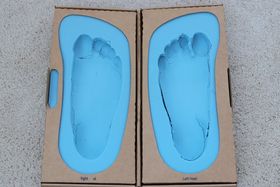Upstep Answers
Our team answers your questions about the causes and treatment of various podiatric conditions, including plantar fasciitis, flat feet, foot pain, and the use of custom orthotics.
Recent Answers
How to Stop Your Inner Ankle From Hurting When Running
Did you notice sudden pain in your ankle while running? Here's what you can do to relieve it.
Asked 7 months ago
High Arches & Overpronation: Can You Have Both at the Same Time?
Navigate the challenges of high arches and overpronation, and discover how to find the perfect solution for your unique needs
Asked 9 months ago
Can You Use FSA or HSA to Buy Custom Orthotics?
If you are interested in buying custom orthotics but are concerned about the cost, it's a little-known fact that you can purchase a pair from Upstep with your FSA and HSA dollars before they expire. W
Asked 9 months ago
How Do You Perform Eccentric Heel Raises Correctly?
If you like to run or take long walks, an eccentric heel raise is a good exercise to incorporate into your home program. Not only does it strengthen the calf muscles, but it also helps prevent Achille
Asked 9 months ago
Golfer's Knee: How to Prevent and Treat Injuries
While golf may seem like a relatively low-risk sport, there is actually a lot that can go wrong. Golf may look like a low-impact sport, but the sheer force that goes into the swing can easily cause in
Asked 9 months ago
Related Articles

DIY Orthotics: Risks of DIY & Safe Custom Alternatives
Janik Sundstrom
July 15, 2025

5 Best Insoles to Wear While Squatting to Aid in Heel Elevation
Babafemi Adebajo
May 14, 2025

Coping with Foot Problems in Pregnancy: Guide for Pregnant Women
Amanda Backus
December 9, 2024

Best Insoles for Pregnancy Foot Pain: Relief for Expecting Moms
Janik Sundstrom
December 5, 2024

Best Shoe Inserts for Comfort in Every Step
Janik Sundstrom
October 11, 2024
Recent Posts
Babafemi Adebajo
Persistent Shin Splints: Why Won’t They Go Away?
Babafemi Adebajo
Vitamins for Shin Splints: Choose the Right Supplements
Babafemi Adebajo
7 Best Orthotics to Aid With Your Lower Back Pain
Babafemi Adebajo
Best Insoles for Plantar Fibroma
Babafemi Adebajo
Out-Toeing—Symptoms, Causes, and Treatments
Janik Sundstrom
The Benefits of Taping for Cuboid Syndrome Treatment
Janik Sundstrom
5 Effective Home Remedies for Burning Feet Syndrome
Babafemi Adebajo



